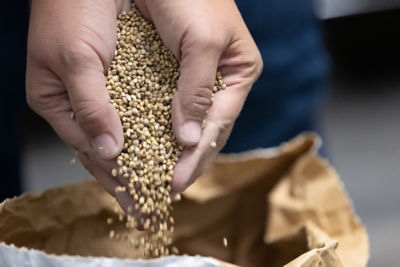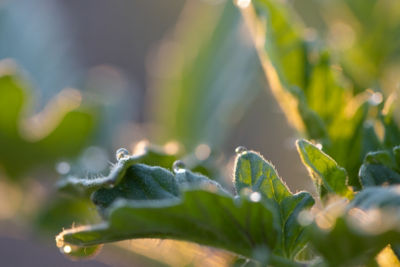Click here to download a PDF version of this spotlight.
» Bacterial wilt can result in substantial yield losses in melon production.
» The bacterial pathogen is spread by striped and spotted cucumber beetles.
» Management of bacterial wilt of melon focuses on controlling the beetle vectors.
Bacterial wilt, caused by the bacterium Erwinia tracheiphila, can be a severe threat to melon production in the eastern parts of the U.S. and southeastern parts of Canada. Bacterial wilt most commonly occurs in the Midwest, Mid-Atlantic, and Northeast regions, where losses of up to 80% have been reported on melons. The disease is also an important problem in cucumber, but squash, pumpkin, and watermelon are less susceptible.1,2
SYMPTOMS
Symptoms of bacterial wilt can develop at any time but are usually most severe on young plants early in the season. The first symptom to appear is a dull green color developing around cucumber beetle feeding wounds. The affected leaf can quickly wilt, followed by a progressive wilting of individual runners up to the wilting and death of the whole plant (Figure 1A).1,3 Seedlings are most susceptible to infection from the cotyledon stage up to the one- to three-leaf stage when the disease can kill the seedling within two weeks. The disease develops more slowly on older plants.
 Figure 1. (A) Bacterial wilt symptoms on a single melon plant. (B) strings of bacterial slime in a positive cut-stem test. Gerald Holmes, Strawberry Center, Cal Poly San Luis Obispo, Bugwood org.
Figure 1. (A) Bacterial wilt symptoms on a single melon plant. (B) strings of bacterial slime in a positive cut-stem test. Gerald Holmes, Strawberry Center, Cal Poly San Luis Obispo, Bugwood org.
The cut-stem test is a diagnostic test that can be performedin the field. To perform the test, first cut a wilted runner with a sharp knife, press the two cut ends firmly together, and then slowly pull them apart while looking for thin strands of bacterial ooze stretching between the cut ends.(Figure 1B). However, this procedure may not work as well with infected melon stems as it does with infected cucumbers. An alternate method is to place a piece of potentially infected stem in water in a small clear container and look for strands or clouds of bacteria streaming out of the cut stem section.1,3
 Figure 2. The (A) striped and (B) spotted cucumber beetles. Jim Jasinski., Ohio State University Extension, Bugwood .org.
Figure 2. The (A) striped and (B) spotted cucumber beetles. Jim Jasinski., Ohio State University Extension, Bugwood .org.
DISEASE CYCLE
The bacterial wilt pathogen is vectored (spread) by the striped and spotted cucumber beetles (Figure 2). The striped cucumber beetle (Acalymma vittate) adults are about ¼ inch long, have black heads and abdomens, and have yellow and black striped wing covers. Spotted cucumber beetles (Diabrotica unecimpunctata howardii) have a black thorax, yellow abdomen, and yellow-green wing covers with 11 or 12 black spots.3,4,5 Adult cucumber beetles start feeding on stems, leaves, and flowers as soon as they emerge. The larvae of these beetles are found in the soil, feeding on plant roots.
When a cucumber beetle feeds on a plant infected with E. tracheiphila, the bacterium becomes established in the intestinal tract of the beetle. In subsequent feedings on cucurbit plants, the beetle will deposit frass (feces) containing the bacterium on the feeding wound site, and the bacterium can infect the plant by entering through the wounded tissue. The bacterium can also enter the plant through floral nectaries when beetles take up nectar from melon flowers. Multiple beetle generations can spread bacterial wilt from plant to plant during the growing season. E. tracheiphila overwinters in adult beetles, although at low rates (7 to 10% of beetles) and infects plants the following season when adult beetles become active and start to feed. Adults usually become active after temperatures are above 54 °F (12 °C).1,2 The severity of bacterial wilt epidemics is closely associated with the size of the cucumber beetle population. The bacterial wilt pathogen is not seed-transmitted and does not survive very long in infested crop debris. However, the pathogen can survive on weeds and volunteer cucurbit plants in some situations.1
Once the bacterium infects the plant, it enters the xylem (water-conducting tissue), where it starts to reproduce and produce extracellular polysaccharides, slimy substances that may contribute to plugging up the xylem and restricting water flow. The presence of bacterial cells is thought to be the main cause of xylem plugging. The rate of symptom development (wilting and plant death) is affected by the amount of bacterium introduced into the plant, the age of the plant, the soil water availability, and other environmental factors. Symptoms can develop within several days of infection on young seedlings.2 Rates of infection and symptom development are lower on older plants, possibly because older plants are less attractive to cucumber beetles. Melon and other cucurbit plants produce chemicals called cucurbitacins that attract cucumber beetles, and seedlings produce more cucurbitacins than older plants. When plants are infected by E. tracheiphila, they also release more volatile compounds that attract cucumber beetles, increasing the likelihood that the beetles will feed on infected plants and further spread the disease.
MANAGEMENT
Resistance to bacterial wilt is not currently available in commercially available melon varieties. Once melon plants are infected by the bacterial wilt pathogen, there is no treatment that can manage the disease. Therefore, management efforts focus primarily on preventing cucumber beetles from feeding on the plants.1 Start by scouting plantings twice a week after transplanting or the emergence of seedlings. Scouting is especially important during the early phases of plant growth. Examine the stems and undersides of cotyledons and leaves for adult beetles and evidence of beetle feeding.5 Initiate insecticide applications at the first detection of cucumber beetles for beetle feeding damage.6 In regions where bacterial wilt commonly occurs, such as the Midwest, an action threshold of one beetle per plant is often used.2
Application of systemic insecticides, such as imidacloprid and acetamiprid, to seedlings prior to transplanting or in-furrow treatments at planting (according to product label instructions) may be warranted in regions where the disease is prevalent.1,2,7 Early season protection from feeding is most important. Contact (and some systemic) insecticides can be applied when beetles begin to appear and after pre-plant applications ofsystemic insecticides have lost effectiveness (often two to three weeks after planting). Contact insecticides that can be used to help manage cucumber beetles include carbaryl, bifenthrin, cyhalothrin, cyfluthrin, permethrin, pyrethrin, and others. Some insecticide products are harmful to bees and other pollinators and should be applied using methods to protect pollinator populations.2,7
There are alternative management strategies that can help reduce the need for insecticide applications directly to the melon crop. Toxic baits containing cucurbitacins and floral volatiles combined with an insecticide, such as carbaryl, can be applied around or within the field to attract and eliminate cucumber beetles. Trap crops can also be planted around the melon field to help keep beetles from entering the melon crop. Blue Hubbard squash and Buttercup squash, in particular, are usually more attractive to beetles than melons. Insecticides can be applied to the trap crop to help manage the beetle population and protect the melon crop from beetle feeding and wilt.1,2,3
Spunbonded row covers can be used early in the season to help exclude cucumber beetles during the initial melon plant growth stages, but the covers should be removed once the plants start to flower. Otherwise, pollination and harvest can be delayed. The use of row covers usually results in additional labor and material costs that may not be economically justified.1,2 Plastic mulches can help lower beetle populations by reducing the survival of cucumber beetle larvae in the soil, and aluminized mulches can help repel adult cucumber beetles from landing on melon plants until vines cover the mulch. Crop rotation away from cucurbit hosts can also help reduce the number of cucumber beetles in the field.3 In smaller operations, roguing out infected plants as soon as they are observed can help reduce the spread of bacterial wilt in the field.1,3
SOURCES
1 Gleason, M. L. and Rojas, E. S. 2017. Bacterial wilt. In Keinath, A., Wintermantel, W., and Zitter, T., Eds. Compendium of Cucurbit Diseases and Pests, Second Edition. American Phytopathological Society.
2 Rojas, E.S., Batzer, J.C., Beattie, G.A., Fleischer, S.J., Shapiro, L.R., Williams, M.A., Bessin, R., Bruton, B.D., Boucher, T.J., Jesse, L.C., and Gleason, M.L. 2015. Bacterial wilt of cucurbits: Resurrecting a classic pathosystem. Plant Disease 99:5, 564-574.
3 Mercure, P., Ng, M., and Ghimire, S. 2023. Bacterial wilt of cucurbits. University of Connecticut. https://ipm.cahnr.uconn.edu/bacterial-wilt/#:~:text=Bacterial%20wilt%20is%20a%20 serious,is%20resistant%20to%20this%20disease.
4Williamson, J. and Griffin, R. 2016. Cucumber, squash, melon & other cucurbit insect pests. Clemson Cooperative Extension. HGIC 2207.
5 Reiners, S., Bellinder, R., Curtis, P., Helms, M., Landers, A., McGrath, M., Nault, B., and Seaman, A. 2017. Cornell integrated crop and pest management guidelines for commercial vegetable production.
6 Williamson, J., Doubrava, N., Blake, J., and Keinath, A. 2016. Cucumber, squash, melon & other cucurbit diseases. Clemson Cooperative Extension. HGIC 2206.
7 Phillips, B., Nair, A., Egel, D., Cloyd, R., and Meyers, S. (Eds.) 2024. Midwest vegetable production guide for commercial growers 2024. https://mwveguide.org/.
Websites verified 4/23/2024
ADDITIONAL INFORMATION
For additional agronomic information, please contact your local seed representative.
Performance may vary, from location to location and from year to year, as local growing, soil and environmental conditions may vary. Growers should evaluate data from multiple locations and years whenever possible and should consider the impacts of these conditionson their growing environment. The recommendations in this article are based upon information obtained from the cited sources and should be used as a quick reference for information about vegetable production. The content of this article should not be substituted for the professional opinion of a producer, grower, agronomist, pathologist and similar professional dealing with vegetable crops.
BAYER GROUP DOES NOT WARRANT THE ACCURACY OF ANY INFORMATION OR TECHNICAL ADVICE PROVIDED HEREIN AND DISCLAIMS ALL LIABILITY FOR ANY CLAIM INVOLVING SUCH INFORMATION OR ADVICE.6011_397609 Published 05/13/2024




